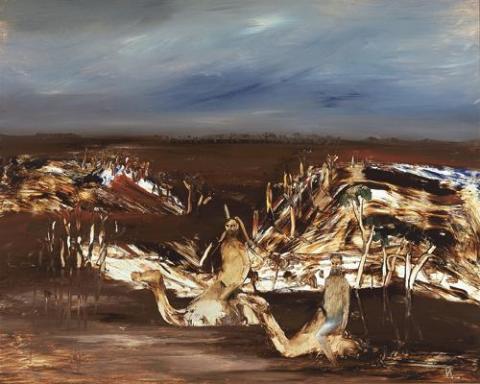BURKE AND WILLS, 1964
Sidney Nolan
oil on composition board
122.0 x 150.0cm
signed with initial lower right: N signed and dated lower left: Oct 1964/ Nolan signed, dated and inscribed verso: Burke + Wills/ B. + Wills/ Nolan/ 1964/ Kym/ October/ For Kym Bonython/ To Adelaide
Kym Bonython Gallery, Adelaide
Company collection, Adelaide
Deutscher~Menzies, Sydney, 5 March 2002, lot 39
Savill Galleries, Sydney
Private collection, Perth
The Burke and Wills Expedition, or as it was known formally, The Victorian Exploring Expedition to the Gulf of Carpentaria, captured the public imagination to the extent that in August 1860 large crowds gathered inMelbourne to witness its departure from Royal Park. Leading Victorian colonial artists, William Strutt and Nicholas Chevalier were there to record the grand occasion. Complete with prancing horses and camels, the irresultant pictures had the all the appearance of a classical Roman triumphal procession rather than the beginning of an Australian expedition of inland exploration. The public interest, which was sustained over the whole of the ill-fated affair and after, was such that nowadays we can look back on a large number of contemporary writings and paintings devoted to it. Foremost are the brilliant drawings and watercolours of Ludwig Becker, official artist on the expedition, together with numerous history paintings by Strutt, Chevalier, Thomas Clark, S.T. Gill, George Lacy, Henricus van den Houten and HenryShort, to mention a few. They reveled in the event or gloried in its heroic tragedy. This was capped off in 1865 by Charles Summers' huge bronze, the Burke and Wills Monument, erected in the City of Melbourne, where it still stands today. The failure of such a major expedition was too painful for gold-rich Victoria to bear. The harshness of reality had to be softened by the grandeur of art and the salve of myth. In the following century Sidney Nolan was to provide both.
Nolan was fascinated by the story of Burke and Wills, in keeping with his deep interest in the heroes and non-heroes of Australia's past. Not only did it have a heady mix of powerful personalities and the magnetic attraction of a failure that should not have happened, it also had, like the Kelly story, a colourful Irishman at its head. Moreover, there was the romantic attraction of man pitted against fearful odds in the furnace of Central Australia. Nolan's Burke and Wills paintings followed on from his Australian travels of 1948, which included flying over the 'dead heart'. He read their diaries, studied engraving and portraits of the time, and wrote poems about Cooper's Creek and another luckless explorer, Ludwig Leichardt. In a letter to his friend, the poet and writer, Geoffrey Dutton, Nolan said:
'I doubt that I will ever forget my emotions when first flying over Central Australia, and realizing how much we painters and poets owe to our predecessors the explorers, with their frail bodies and superb will-power.'1
In Burke and Wills, Nolan shows the explorers naked to emphasize that they are defenseless against the environment. It is said that people in the agony of thirst take off their clothes. This is given a biting twist by partly immersing the two camels in water. The poignant fact is that the only water Burke and Wills experienced to this extent was in the mangrove swamps near the Gulf of Carpentaria, where the camels became knee deep in water. While other 'geographical' solutions may be sought, it is unlikely that Nolan had a specific place in mind, rather that he was portraying them as archetypal explorers- not just Burke and Wills, but all Australian inland explorers. Extended universally, they are a metaphor for the heroism of all who pit themselves against the vastness of Nature. Variations of this kind are not uncommon in Nolan's work, an important example being the 1966 painting, Camel and Figure in the collection of the Tate Gallery, London. Nolan introduced Lake Frome into the background of this painting, a lake that was not on the inland route taken by Burke. Interpretation of images aside, the two paintings share a wonderful fluidity of paint and mastery of colour.
1. Quoted in Clark, J., Sidney Nolan Landscapes & Legends: a retrospective exhibition: 1937-1987, National Gallery of Victoria, Melbourne 1987, p.95
DAVID THOMAS
